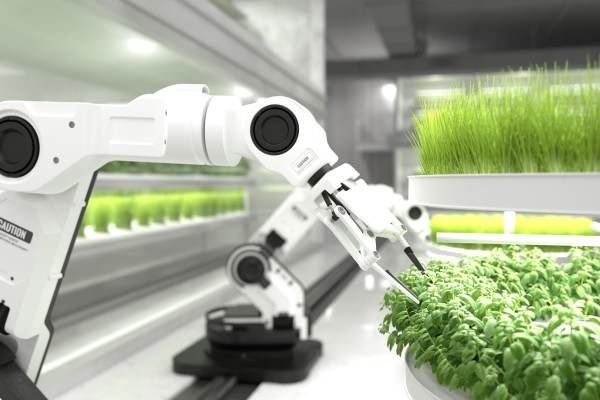Introduction
An important component of contemporary agriculture, crop yield prediction is important for both farmers and policy makers. This effort has historically relied on historical data analysis and statistical models. But the development of machine learning (ML) algorithms has completely transformed this field and opened up new possibilities for more accurate forecasting.

Table of Contents
Importance of crop yield prediction in agriculture
Prediction of crop production is essential for risk management, resource allocation and agricultural planning. It gives farmers the ability to make informed decisions about planting dates, irrigation plans, fertilizer applications and pest management techniques. Furthermore, the maintenance of food security and economic stability in agricultural communities depends on accurate production estimates.
Potential of Machine Learning to Revolutionize Crop Yield Forecasting
Crop production forecasting can be revolutionized by machine learning techniques, which analyze large datasets and provide accurate predictions. More accurate forecasts can be generated through machine learning (ML) by identifying complex patterns and correlations in agricultural data using techniques such as regression, decision trees and neural networks.
Moving from Traditional Techniques to Machine Learning Algorithms
In the past, crop production forecasting was based on traditional statistical techniques, which often made it difficult to account for the complexity of agricultural systems. By enabling algorithms to repeatedly learn from data and modify and enhance their predictions over time, machine learning marks a paradigm shift.
Important difficulties in crop yield forecasting and how machine learning solves them
Irregular weather, poor soils, insect infestations and changing market dynamics are hampering agricultural yield forecasting. Machine learning tackles these problems by combining multiple data sources, such as satellite imaging, weather predictions, soil structure data, and market trends. ML improves prediction accuracy and dependability in this way.
Comparison of traditional and machine learning methods for crop yield forecasting

In terms of forecasting accuracy, scalability, and adaptation to changing agricultural contexts, machine learning algorithms perform better than traditional techniques. Traditional models may be based on overly simplifying assumptions, but machine learning (ML) algorithms are able to capture complex correlations between multiple factors, making estimates more robust.
Maximizing Crop Yields with Machine Learning in Agriculture by Leveraging Big Data
There is a wealth of data accessible due to the widespread use of data collection technology in agriculture, including drones, IoT sensors, and satellite imaging. Large data sets are easily processed and analyzed by machine learning, generating practical results that optimize crop management strategies and increase yield potential.
Structure of Machine Learning Algorithm for Crop Yield Prediction
Machine learning algorithms for agricultural yield prediction typically involve several steps, such as feature selection, training, evaluation, and preprocessing of data. In this field, the common methods adopted are Support Vector Machine, Random Forest, Convolutional Neural Network (CNN), Recurrent Neural Network (RNN), and other deep learning models.
Practical Use of Machine Learning to Forecast Crop Yields
Machine learning is being used in the real world to forecast agricultural yields for different crops and geographic regions. Machine learning algorithms are used in precision agriculture to detect crop diseases early, optimize irrigation schedules, and suggest special fertilizer regimens. ML-based models are also used by agricultural insurers to evaluate and mitigate risks related to crop variability.
Progress and Innovation of Machine Learning for Crop Yield Prediction
The field of machine learning is constantly evolving, pushing the boundaries of agricultural production forecasting. Advances such as explainable AI, collective learning, and transfer learning have the potential to significantly increase prediction accuracy, interpretability, and scalability in agricultural settings.
Conclusion
In agricultural production forecasting, machine learning algorithms have become extremely useful tools with previously unheard of capabilities to handle the complexities of contemporary agriculture. Sustainable agricultural practices and improved global food security are made possible by these algorithms, which harness the power of big data and sophisticated analytical approaches.
- You might be interested in reading these posts as well
- Quantum machine learning algorithms for drug discovery applications
- Machine learning algorithms in quantum computing a survey
- Which algorithm is used in machine learning
FAQs
High levels of accuracy can be achieved by machine learning forecasts for agricultural yields, especially when they are tested against real-world observations and trained on extensive datasets. Many variables can affect accuracy, including the capacity of input data, the complexity of the farming system, and the machine learning method selected.
A variety of data sources are used by machine learning algorithms to predict crop production, including past yield data, weather records, soil properties, satellite images, crop health measures (such as NDVI), presence of pests and diseases. Data on, market trends are included. , and agricultural practices. By incorporating these multiple data sources, machine learning models are able to accurately represent various aspects that affect agricultural yield.
Yes, by using localized data and adding variables unique to a certain location into their models, machine learning algorithms can accommodate variations in farming practices across different regions. ML models trained on data from one location can generalize and adapt to comparable regions with different characteristics, thanks to techniques like ensemble methods and transfer learning. Furthermore, feedback loops and ongoing model updates allow for rapid adaptation to changing agricultural conditions.
Pingback: Machine Learning Algorithms for Efficient Water Quality Prediction
Pingback: Machine Learning Optimization Algorithms & Portfolio Allocation